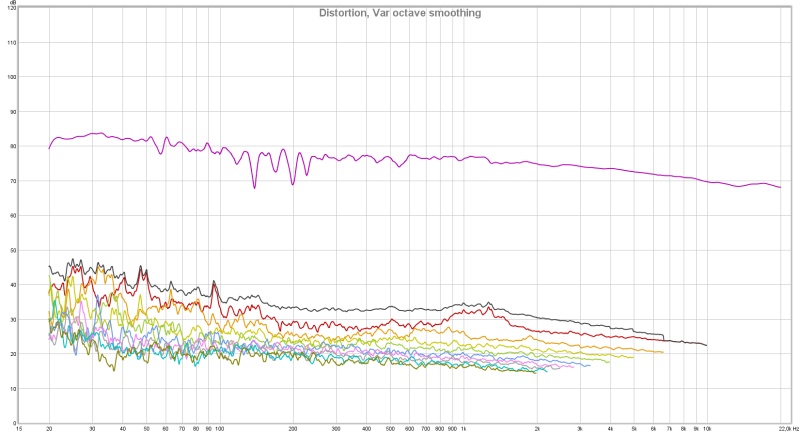I have a big bag of Bugles 😀
Burp, don't forget the beer!
Been over two decades since I built a line array, but none the less good stuff here.
Burp, don't forget the beer!

Been over two decades since I built a line array, but none the less good stuff here.

Following the Towers for some time now.
It inspired me to consider building one for myself. I'm starting soon, I guess.
Awesome thread 🙂
It inspired me to consider building one for myself. I'm starting soon, I guess.
Awesome thread 🙂
Long time no see! How's that amplifier coming along?
Replacement parts on hand but not installed yet. Too much on my plate atm and soaring season is open 😀
https://vimeo.com/81879622
cool. been paragliding, but never tried a glider. don't need a launcher for paragliding, just need to hike a mountain.
One thing I just had to find out is where the dips in my measurements come from as seen here:

This is a stereo measurement. The dips between 140-235 are from the right channel, the wiggle at 60 Hz is appearing in both but way stronger in the left channel.
At first I tried to change the clamping force on the baffle on the right speaker. I added rubber and extra clamping on the bolts 5 speakers apart to see if that solved anything. It didn't. It actually only made the dips deeper/sharper.
So my next quest was to swap the left and right speaker phisically, without undoing the extra clamping so I could detect it clearly. It could be the speaker itself right? A resonating baffle, you name it.
But after swapping speakers the left result looked exactly like it always did on the left side (wiggle at 60 Hz) and the right still had the same/similar dips at the same frequencies too.
So it is actually a room thing, or at least with the speaker in that exact same spot.
It taught me to reverse the extra clamping on the original right speaker, now standing on the left side. It also showed me the original left placed speaker had similar deeper dips as when I raised the clamping on the other (original right) one. The left corner position is more forgiving in the mid frequencies so I hadn't noticed that. But it's no surprise as the impedance test on the left speaker had always been a fraction more restless than the right one. So I'll work on both, might even have to check impedance to get them at their best behaviour.
Can't say I noticed the difference in listening though, but sometimes knowing is enough. To further test the dips I placed damping material on the short wall next to the right speaker. Curiously that made no real difference at all.
Still enjoying music in between these crazy sessions, sometimes wondering why I still do all those crazy experiments which sometimes mess up perfectly good sound.
In short: I just want to learn as much as I can from these speakers and their related behaviour in my room. Meanwhile they are in use for home theatre and music playing and doing a very good job with both duties. I watched "Rush" last weekend and what a rush is was!
Really enjoyed the starting of the engines coming from everywhere before the start of a race.

Too bad I couldn't blast it full power with my kid asleep upstairs.

This is a stereo measurement. The dips between 140-235 are from the right channel, the wiggle at 60 Hz is appearing in both but way stronger in the left channel.
At first I tried to change the clamping force on the baffle on the right speaker. I added rubber and extra clamping on the bolts 5 speakers apart to see if that solved anything. It didn't. It actually only made the dips deeper/sharper.
So my next quest was to swap the left and right speaker phisically, without undoing the extra clamping so I could detect it clearly. It could be the speaker itself right? A resonating baffle, you name it.
But after swapping speakers the left result looked exactly like it always did on the left side (wiggle at 60 Hz) and the right still had the same/similar dips at the same frequencies too.
So it is actually a room thing, or at least with the speaker in that exact same spot.
It taught me to reverse the extra clamping on the original right speaker, now standing on the left side. It also showed me the original left placed speaker had similar deeper dips as when I raised the clamping on the other (original right) one. The left corner position is more forgiving in the mid frequencies so I hadn't noticed that. But it's no surprise as the impedance test on the left speaker had always been a fraction more restless than the right one. So I'll work on both, might even have to check impedance to get them at their best behaviour.
Can't say I noticed the difference in listening though, but sometimes knowing is enough. To further test the dips I placed damping material on the short wall next to the right speaker. Curiously that made no real difference at all.
Still enjoying music in between these crazy sessions, sometimes wondering why I still do all those crazy experiments which sometimes mess up perfectly good sound.
In short: I just want to learn as much as I can from these speakers and their related behaviour in my room. Meanwhile they are in use for home theatre and music playing and doing a very good job with both duties. I watched "Rush" last weekend and what a rush is was!
Really enjoyed the starting of the engines coming from everywhere before the start of a race.
Too bad I couldn't blast it full power with my kid asleep upstairs.
Attachments
Taking care of the room at freq between 20 to 300Hz is probably the hardest thing to do.
Most people would be ecstatic having a freq sweep like the one above, even with those very small dips.
But, you're the guy who took all that time to build his arrays, with all that patience you had, I am confident that, in time, you will resolve those little dips someday.
And yes, arrays for movie time are amazing!
Most people would be ecstatic having a freq sweep like the one above, even with those very small dips.
But, you're the guy who took all that time to build his arrays, with all that patience you had, I am confident that, in time, you will resolve those little dips someday.
And yes, arrays for movie time are amazing!
As far as your baffles go the only thing I would add is to torque each screw the same.
Placement and room boundries play a big roll in this critical low mid region. Have you tried placing pillows on the floor when taking measurements? This is common practice with normal speakers, so I would fathom to say doing the same to reduce ceiling bounce with a full line array is neccessary.
Wait'n on what the awesome patterns for these designer pillow treatments that'll pull the wall art et al together. 😉
Placement and room boundries play a big roll in this critical low mid region. Have you tried placing pillows on the floor when taking measurements? This is common practice with normal speakers, so I would fathom to say doing the same to reduce ceiling bounce with a full line array is neccessary.
Wait'n on what the awesome patterns for these designer pillow treatments that'll pull the wall art et al together. 😉
Nice achievement... I wouldn't bother too much about the dips, unless they audibly disrupt the soundstage...One thing I just had to find out is where the dips in my measurements come from as seen here:
As far as your baffles go the only thing I would add is to torque each screw the same.
Placement and room boundries play a big roll in this critical low mid region. Have you tried placing pillows on the floor when taking measurements? This is common practice with normal speakers, so I would fathom to say doing the same to reduce ceiling bounce with a full line array is neccessary.
Wait'n on what the awesome patterns for these designer pillow treatments that'll pull the wall art et al together. 😉
I agree with you here about the baffle. When I did the impedance tests I had the best result with half of the bolts supplied with a rubber ring. I'll revisit that solution and look for a smaller torque wrench. I only have big ones for Car stuff.
I suspect my ceiling will be one of the mayor problems left. I hope to resolve that sometime soon. The floor reflection should aid the line effect. The gap I have between the lines and the ceiling is big enough to cause problems. The one thing I want to figure out is the difference between left and right. I haven't got a symmetrical setup but expected the right one to do better in that regard.
No custom pillows yet 😀.
Nice achievement... I wouldn't bother too much about the dips, unless they audibly disrupt the soundstage...
The pretty FR picture is from a previous measurement although the current ones resemble it closely.
I don't think the dips disrupt the soundstage but can't be sure if I don't try right? The difference between right and left do cause a dip in response between 60 to 70 Hz that I fill in by lowering the left output and raising right in that region. It is a room effect but I'd be happier if I didn't have to solve it like this.
Another question for you guys... Currently I'm using my DAC trough S/PDIF to run the speakers. I'd like to use the Asus Xonar ST but as explained I have a noise problem (50 Hz hum) when I use that.
I have two big caps left, 12000 uF 40VDC salvaged from an old lab power supply.
Could I use those to clean up the power on the 4 pin Molex entering my soundcard? One for the 5 volt and one for the 12 volt by putting them parallel to the power + and - ? The Molex sadly isn't a real Molex from my power supply but an adapter from a SATA power supply split from one of the free SATA power connectors. The other two power supply connectors on that line feed my 2 WD Black 2 TB data drives.
Here's a picture:

I used one of those to clean up a power supply to my car radio I have installed in my garage/workshop. Still have 2 left...
Alternatively I could use the 12 volt for the Molex from one of the two six pin graphics card connectors that are not in use. Using only the 5 volt line from
the SATA to Molex adaptor. Not sure if that is needed though. But I do know the original Molex had a higher power rating vs the SATA.
Last edited:
Before trying the huge caps have you tried these stuff:.....Another question for you guys... Currently I'm using my DAC trough S/PDIF to run the speakers. I'd like to use the Asus Xonar ST but as explained I have a noise problem (50 Hz hum) when I use that.
I have two big caps left, 12000 uF 40VDC salvaged from an old lab power supply.
Could I use those to clean up the power on the 4 pin Molex entering my soundcard?.....
Use SPDIF via TOSKON to DAC instead of electric SPDIF which will completely isolate ground potentials and the need for it.
Checked if swapping neutral and hot phase at live power plug for computer or DAC makes a difference to the hum.
The ground potential at ASUS Xonar ST is probably its own some isolated virtual ground potential having high impedance to rest of computer circuits ground and safety earth. Make a trial and see if hum goes away with those huge caps but would imagine your computer PSU wont start if seeing into the load these huge caps make at startup and therefor would need a soft startup circuit for those two caps to blend their load slowly into power rails.
Well S/PDIF out to dac does not give any hum at all, that's not the problem.
I'd like to not use the separate DAC but the DAC in the Asus instead. I have an add on card giving me a total of 6 channels to play with 😉.
I was figuring the caps might be a bit big giving me problems. I might try a separate (older) power supply with a true Molex with the caps to feed the Asus Xonar ST.
I'd like to not use the separate DAC but the DAC in the Asus instead. I have an add on card giving me a total of 6 channels to play with 😉.
I was figuring the caps might be a bit big giving me problems. I might try a separate (older) power supply with a true Molex with the caps to feed the Asus Xonar ST.
Last edited:
Just remember molex connectors are notorious for bad connections. When new and tight they can handle the rated current, but mess with them much and they burn under load due to the increased contact resistance. When dealing with grounds, nothing beats a solid gas tight bond. System may not start with the big caps would be nice, have seen them take out the power rails, back feed power and smoke the whole caboose.
BTW I dispise automotive ground blocks for this reason, an issue since last summer yet to be resolved causing cooling system issues. Bought a light weight torque wrench a month or so ago for those light tasks under the hood... recently replaced the lower manifold gasket. A/C is still defunct at upper fan speeds or when it just decides it doesn't want to run. Which sucks as summer has been here for a month now. To get to the ground block seems half the engine must be removed uggg. Weee fun 🙂
BTW I dispise automotive ground blocks for this reason, an issue since last summer yet to be resolved causing cooling system issues. Bought a light weight torque wrench a month or so ago for those light tasks under the hood... recently replaced the lower manifold gasket. A/C is still defunct at upper fan speeds or when it just decides it doesn't want to run. Which sucks as summer has been here for a month now. To get to the ground block seems half the engine must be removed uggg. Weee fun 🙂
Some of these days, you know why you're in a hobby like this...
I've been playing music non stop for a while now. All kinds I must say.
Before this weekend I had nice sound, after a big long measuring session. But I remembered something was more right after a previous measuring session.
There was something wrong/off at that time too. The bass wasn't right, something was off. But when I got that right again, the depth was missing.
So I was partly pleased before going into a long weekend where family life would prohibit me from listening much.
We used the speakers for a movie for my son but I figured not to turn on my music and driving my fellow family members insane. Yesterday I changed one little thing while the rest was showering. Didn't have the time to really listen.
So today I got time alone in the house and sat down. Chills all over, I'm not listening to songs. They are musical events. It's almost like I've build a time machine. Stereo really does work! 😱
And for those that think the TC9 doesn't have enough DDR, try 50 of them 😉.
I've been playing music non stop for a while now. All kinds I must say.
Before this weekend I had nice sound, after a big long measuring session. But I remembered something was more right after a previous measuring session.
There was something wrong/off at that time too. The bass wasn't right, something was off. But when I got that right again, the depth was missing.
So I was partly pleased before going into a long weekend where family life would prohibit me from listening much.
We used the speakers for a movie for my son but I figured not to turn on my music and driving my fellow family members insane. Yesterday I changed one little thing while the rest was showering. Didn't have the time to really listen.
So today I got time alone in the house and sat down. Chills all over, I'm not listening to songs. They are musical events. It's almost like I've build a time machine. Stereo really does work! 😱
And for those that think the TC9 doesn't have enough DDR, try 50 of them 😉.
- Home
- Loudspeakers
- Full Range
- The making of: The Two Towers (a 25 driver Full Range line array)

